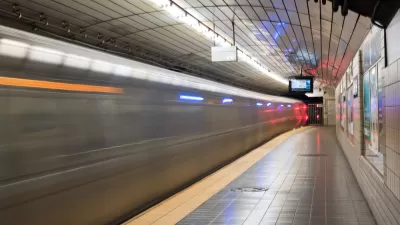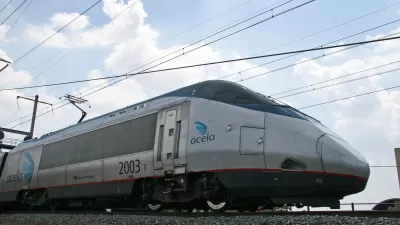Dirty looks, shushing, even brawls; the lengths that "vigilantes" take to policing the rules of railroad quiet-cars can be extreme. William Power and Brian Hershberg look at how different transit systems, and their passengers, enforce quiet rides.
In this age of smartphones, tablets, and personal audio systems, finding a respite from the cacophony can be a challenge. But, as Power and Hershberg note, "In theory, and often in reality, the quiet car has been a haven for commuters seeking peace. Passengers who desire quiet stay in a designated car, and chatty types in the rest."
Yet, with many systems relying on self enforcement, "passenger-on-passenger policing is just what can happen as the quiet-car concept continues to expand to more railroad lines. Best-known on Amtrak, the shhh-cars are an option on local train lines in places including New York, Pennsylvania, Virginia, Illinois and California. While some of the quiet cars have clear signs with the rules, others roll up with none."
"One of the biggest myths about quiet cars, say transit officials, is that the rules have legal authority," explain Power and Hershberg. "Most of the time, the quiet ride relies on riders to voluntarily comply—by talking in 'library voice' and disabling sounds on all electronic devices."
"Septa, for example, says riders shouldn't expect to hear a pin drop. 'It's the quiet car, not the silent car,' says Kim Scott Heinle, assistant general manager for customer service and advocacy."
FULL STORY: Shhh! 'Quiet Cars' Turn Commuters Into Librarians

Study: Maui’s Plan to Convert Vacation Rentals to Long-Term Housing Could Cause Nearly $1 Billion Economic Loss
The plan would reduce visitor accommodation by 25,% resulting in 1,900 jobs lost.

Alabama: Trump Terminates Settlements for Black Communities Harmed By Raw Sewage
Trump deemed the landmark civil rights agreement “illegal DEI and environmental justice policy.”

Why Should We Subsidize Public Transportation?
Many public transit agencies face financial stress due to rising costs, declining fare revenue, and declining subsidies. Transit advocates must provide a strong business case for increasing public transit funding.

Paris Bike Boom Leads to Steep Drop in Air Pollution
The French city’s air quality has improved dramatically in the past 20 years, coinciding with a growth in cycling.

Why Housing Costs More to Build in California Than in Texas
Hard costs like labor and materials combined with ‘soft’ costs such as permitting make building in the San Francisco Bay Area almost three times as costly as in Texas cities.

San Diego County Sees a Rise in Urban Coyotes
San Diego County experiences a rise in urban coyotes, as sightings become prevalent throughout its urban neighbourhoods and surrounding areas.
Urban Design for Planners 1: Software Tools
This six-course series explores essential urban design concepts using open source software and equips planners with the tools they need to participate fully in the urban design process.
Planning for Universal Design
Learn the tools for implementing Universal Design in planning regulations.
Smith Gee Studio
Alamo Area Metropolitan Planning Organization
City of Santa Clarita
Institute for Housing and Urban Development Studies (IHS)
City of Grandview
Harvard GSD Executive Education
Toledo-Lucas County Plan Commissions
Salt Lake City
NYU Wagner Graduate School of Public Service





























